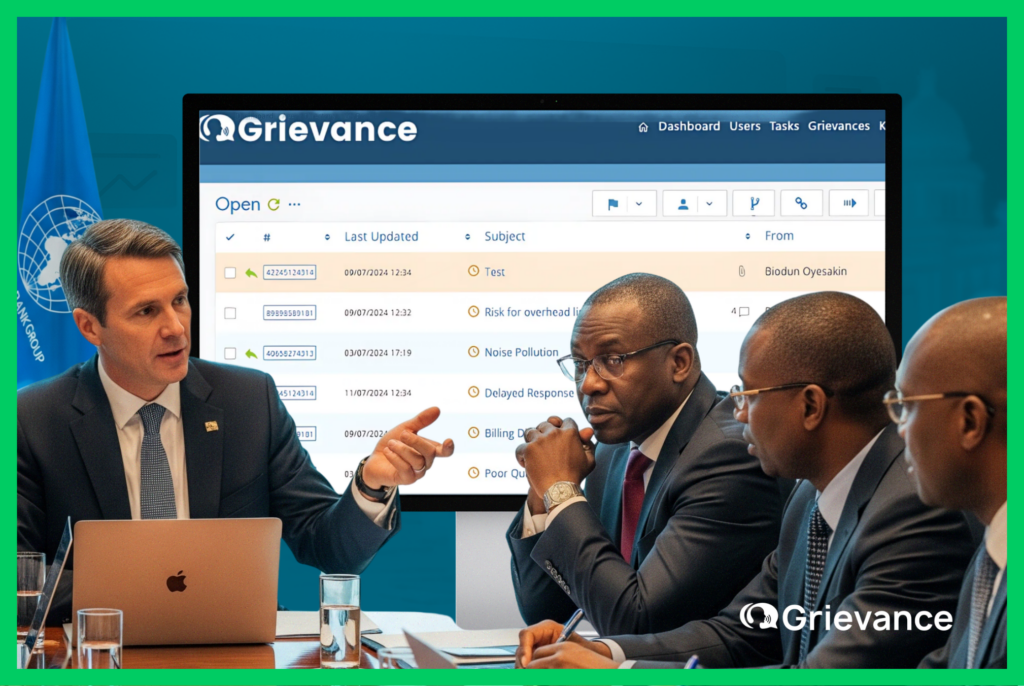International GRM Standards: Are You Compliant with International GRM Standards?

When your organization oversees high-impact infrastructure or socio‑economic projects, failing to meet international GRM standards isn’t just a compliance issue, it’s a risk to credibility, trust, and funding. International donors, UN agencies, and development banks demand transparent, traceable grievance redress mechanisms that align with global norms. But are you truly compliant with international GRM standards, or simply ticking boxes?
In this article, we’ll clarify the core expectations behind key frameworks World Bank’s Environmental and Social Framework (ESF), IFC’s Performance Standards, UN GP Principles, OECD due diligence, and EU Sustainable Finance rules. You’ll discover what each standard requires, common gaps, and how a robust platform like Grievance App helps you meet them. If you work in an international organization, government authority, NGO, or multilateral institution, this is your roadmap to ensuring that your grievance handling is not only operational but also standard-compliant and defensible.
Understanding Core International GRM Standards
What Are the International Standards for Grievance Mechanisms?
These globally adopted frameworks define expectations for fairness, accessibility, transparency, and accountability in managing complaints:
- World Bank ESF / IFC Performance Standards: expect a formal grievance redress structure as part of social impact management.
- UN Guiding Principles (UNGPs): require effective remedy, grievance channels for impacted communities, and operational-level mechanisms.
- OECD Due Diligence Guidance: expects enterprises and financiers to have grievance procedures that enable remediation across supply chains.
- EU Sustainable Finance Regulation: emphasizes grievance systems as critical for ESG reporting and sustainable governance.
Key compliance dimensions:
- Accessibility and multilingual submission
- Confidentiality, anonymity, and protection
- Timely, structured response process
- Escalation pathways and auditability
- Monitoring, metrics, and continuous improvement
How to Assess Compliance with International GRM Standards
Map your current grievance process
-
- Are submission paths (online, in-person, phone, paper) clearly documented?
- Can complainants submit anonymously or in preferred languages?
Evaluate your response and tracking
-
- Do you timestamp and log every complaint step?
- Can you escalate overdue cases automatically?
Check your reporting and governance
-
- Do dashboards track KPIs like resolution time or volume from marginalized groups?
- Are senior managers notified of critical unresolved grievances?
Using an integrated GRM platform ensures consistent alignment with international GRM standards, while reducing manual gaps.
Grievance App and International GRM Standards: Why It Matters
International GRM standards often require traceable, structured, and secure systems. Grievance App delivers:
- Multilingual and anonymous submission across web/mobile channels
- Automated timestamps and traceable escalation routes
- Categorization, AI‑assisted resolution tools, dashboards, and performance metrics
- Role‑based access, audit trails, regulatory compliance (SLA, GDPR)
This means that your grievance system becomes fully compliant by design, minimizing litigation and reputational risks tied to non-compliance.
Bridging Compliance Gaps: Common Weak Points
Even well‑intentioned organizations often miss key aspects:
- Missing anonymous or accessible submission channels
- Lack of escalation or reminder workflows for unattended complaints
- Weak data governance or incomplete audit logs
- Insufficient reporting on resolution quality or stakeholder satisfaction
Solution checklist:
- Standardized templates and escalation logic
- Dashboards with real‑time KPIs
- Audit trails with full journalization of user actions
- Integration with third‑party APIs for case files, translation, or identity verification
Benefits of International GRM Standards Compliance
Adhering to global grievance frameworks isn’t just regulation; it supports real organizational value:
- Builds credibility with international funders (World Bank, AfDB, EU, UN, ECOWAS)
- Enhances stakeholder trust, especially among affected communities
- Reduces litigation and social conflict risk through proactive resolution
- Improves operational efficiency, centralizing all complaint workflows
- Supports robust ESG reporting, aligning with sustainable finance rules
Conclusion
Meeting international GRM standards is essential for any global or regional institution involved in socio-economic or infrastructure projects. Non‑compliance threatens funding, legitimacy, and stakeholder trust. On the other hand, implementing a purpose-built GRM platform like Grievance App ensures you’re aligned with donor mandates by design.
Ready to transform your grievance processes into a fully compliant, transparent, and efficient standard bearer?. Click here to schedule a free demo and ensure your GRM is compliant and credible.
FAQ international GRM standards
1. What are “international GRM standards”?
They refer to globally recognized frameworks like World Bank ESF, IFC Performance Standards, UNGPs, OECD Due Diligence, and EU Sustainable Finance that set principles for grievance redress mechanisms.
2. How do I know if my GRM is aligned with international GRM standards?
Check if your system supports anonymous, multilingual access; automated timestamps; escalation pathways; KPI dashboards; and full audit trails.
3. Can Grievance App help me comply with international GRM standards?
Yes. Grievance App offers fully traceable, multilingual submissions, AI‑assisted workflows, dashboards, escalations, role‑based access, and GDPR/SLA compliance.
4. Why is compliance with international GRM standards important?
Compliant GRMs bolster accountability, satisfy requirements from donors like the World Bank or AfDB, mitigate risk, and build trust with impacted communities.
5. How quickly can I implement a GRM that meets international GRM standards?
Deployment times vary, but digital platforms like Grievance App can often be live within weeks, minimizing delay while maximizing compliance.
